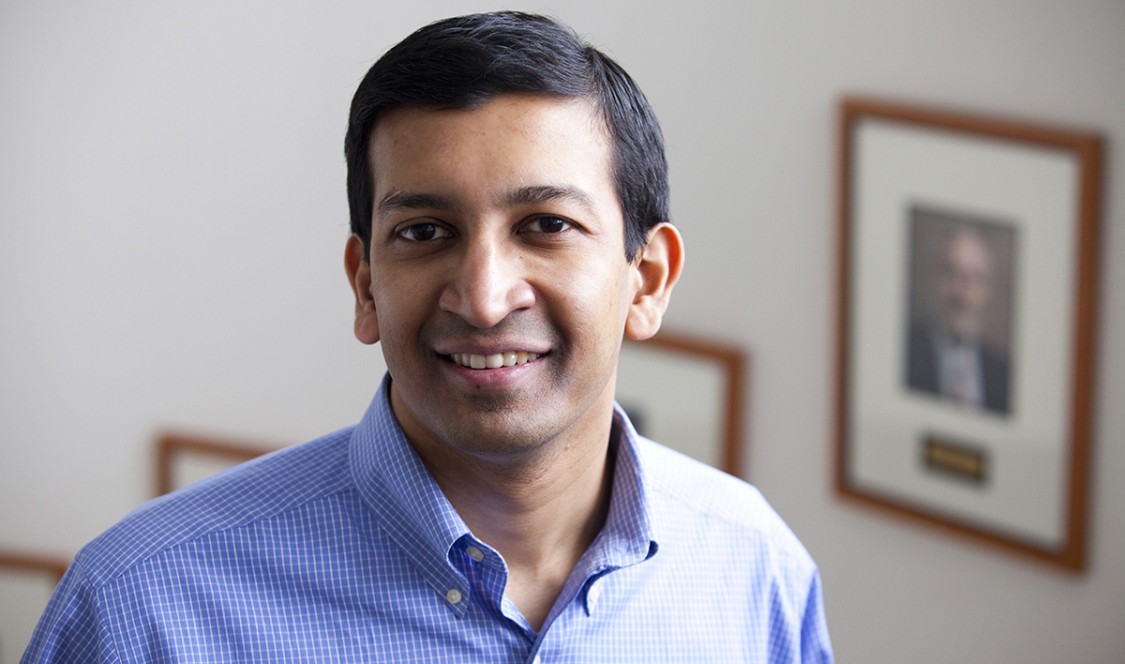As a child in India, Raj Chetty dreamed of coming to America, a place “where you could do anything.” He still believes that. But his Opportunity Atlas research also shows that the American Dream is far too elusive for many who grow up here, through no fault of their own except a geographical luck-of-the-draw that has prevented millions from accessing high opportunity resources.
Chetty, the William A. Ackman Professor of Public Economics at Harvard University, opened the spring Marian Miner Cook Athenaeum season with his Jan. 25 talk, “Where Opportunity Happens: How Neighborhoods Affect Social Mobility.” Through the use of various maps from his Opportunity Atlas, Chetty demonstrated how he uses gigantic data sets to inform smarter, stronger, and more effective government policies—which in the end, can help those most in need. Specifically, his project draws from tax and census records to illustrate how a residential zip code—where a child grows up—is more predictive of social mobility and economic fate than any other national metric.
“As scientists trying to understand the drivers of economic mobility, this sort of data gives us a very powerful lens to dig deeper,” said Chetty, the youngest tenured professor in Harvard’s history and a MacArthur Foundation Genius Grant awardee. “Exactly why is it that we are seeing much higher levels of upward mobility in Salt Lake City than in Cincinnati?”
Among the key takeaways from his research:
- Race matters: By linking tax data to census data, Chetty showed a pair of maps comparing opportunity prospects for Black men and white men—a difference so stark that you basically “have two different countries for opportunities,” he said. Upward mobility is especially worse for Black men because of high rates of incarceration and certain kinds of discrimination. Chetty’s analogy: If achieving the American Dream is like climbing an income ladder, Black men are on a treadmill. “Even after they’ve climbed up one generation, there are tremendous structural forces that can have them fall back down quite significantly.”
- Local matters: Chetty used data map comparisons in L.A. neighborhoods Watts and Compton to show how vast the differences in incarceration rates and outcomes can be just a few miles away. Same with Boyle Heights and Montecito Heights. The hyperlocal difference means that moving from a low opportunity area to a high opportunity one—even within the same general radius—can have a dramatic impact on outcomes, in particular, lifetime wages. “The childhood years drive changes and outcomes in the long run. Every extra year of exposure to a better environment, and the earlier you move to that better neighborhood, the better you do.”
- Support matters: As demonstrated with a successful housing voucher project he helped implement in Seattle, Chetty said working with local authorities on providing additional resources for families—search assistance, engagement with landlords, and short-term financial assistance—led to far greater mobility for those trying to move out of concentrated poverty. It was also an example of how investments in social capital—the “it takes a village” philosophy of receiving help from others—is an important catalyst for opportunity outcomes.
That’s especially true for access to education, with Chetty showing a data map of how CMC (and other colleges) offer strong rates of mobility for students from low opportunity backgrounds who attend. However, a greater societal impact and influence from higher education would be felt if a larger volume of students from underrepresented areas were admitted to the best colleges.
“It’s not that students can’t afford college because of the cost, because a lot of colleges have made it quite affordable,” Chetty said. “It’s that they’ve never met anyone who went to college, or went on to found an important business, or become a scientist. … it’s about environment shaping aspirations.”
Chetty will continue his Ath conversation with College leadership on Feb. 2 at a ResPublica Society roundtable, “Opportunity Happens Here: How Selective Liberal Arts Colleges Affect Social Mobility.” Some of his solutions center on deeper engagement—like CMC’s Kravis Opportunity Fund (which focuses on costs beyond tuition) or first-year coaching and success consultants—that are crucial to consistent student interventions on campus. “That kind of help is quite important to help kids stay on track,” Chetty said.
As for how data can continue to drive impact—a core CMC Strategy priority given the College’s commitment to integrated science—Chetty said he hopes his Harvard class on solving social problems will be a model for teaching economics. In response to a student question, Chetty said while his class draws from traditional methods, he “personalizes” the material through his Opportunity Atlas so students can “think about their own neighborhoods, and think about how life could be different for them.”
“It’s an incredibly important and exciting time to be a social scientist, as we finally have the data to study these questions rather than just speculate about them theoretically,” Chetty said. “There are immense opportunities for doing research on these issues, acquiring skills, and applying them to the policy world or private sector.”

